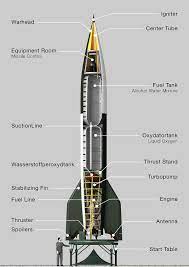Ballistic missiles are an essential component of modern military arsenals, designed to deliver a warhead to a target after being launched into the air and following a parabolic trajectory. They were first developed during World War II by Germany. Today, countries around the world invest heavily in their ballistic missile programs, and they are constantly evolving with new technological advancements.

Table of Contents
Types of Ballistic Missiles
There are two types of ballistic missiles: intercontinental ballistic missiles (ICBMs) and shorter-range ballistic missiles (SRBMs). ICBMs are capable of delivering a warhead anywhere in the world, with a range of more than 5,500 km. SRBMs, on the other hand, are intended for regional conflicts, with a range of less than 1,000 km.
Design and Function of Ballistic Missile
Ballistic missiles are powered by rocket engines, which provide the initial thrust to get the missile moving. After that, they follow a ballistic trajectory that is determined by the Earth’s gravitational pull. The design of ballistic missiles makes them difficult to detect and intercept, as they are usually launched from mobile platforms such as trucks or submarines.
Evolution of Ballistic Missile Technology
Countries such as the United States, Russia, China, and North Korea invest heavily in ballistic missile technology, constantly innovating to develop new and advanced missile systems. Some of the latest developments in ballistic missile technology include hypersonic glide vehicles, which are capable of traveling at speeds of more than five times the speed of sound, and maneuverable reentry vehicles, which can change direction and altitude during their descent, making them even harder to intercept.
Impact on Global Security and Politics
The development of ballistic missiles has had a profound impact on global security and politics. The ability to launch a missile from one country and hit a target in another has led to an arms race between countries and has raised concerns about the possibility of nuclear war. Missile defense systems have been developed to intercept and destroy incoming ballistic missiles.
Ballistic Missiles of India
India is one of the few countries in the world that has developed its own ballistic missile technology. The country’s missile program began in the 1960s with the development of the first Indian-made rocket, called the Rohini-75. Since then, India has continued to invest heavily in its missile program, developing a range of ballistic missiles that are capable of delivering both conventional and nuclear warheads.
India has developed a number of different types of ballistic missiles, including short-range ballistic missiles (SRBMs), medium-range ballistic missiles (MRBMs), intermediate-range ballistic missiles (IRBMs), and intercontinental ballistic missiles (ICBMs). Some of the most prominent missiles developed by India include:
- Agni: A series of MRBMs and IRBMs that have ranges of up to 5,000 km. The Agni missiles are designed to be road-mobile and can be launched from multiple platforms.
- Prithvi: A series of SRBMs with ranges of up to 350 km. The Prithvi missiles are capable of carrying both conventional and nuclear warheads and are also road-mobile.
- Sagarika: A submarine-launched ballistic missile (SLBM) that can deliver a nuclear warhead up to 700 km away.
India’s Ballistic Missile Defense Program
India has also developed a ballistic missile defense (BMD) program, which is designed to intercept and destroy incoming ballistic missiles. The program includes the development of several different types of interceptors, including the Prithvi Air Defense (PAD) missile and the Advanced Air Defense (AAD) missile. The BMD program has been tested successfully several times, including in March 2019 when India shot down a live satellite in orbit, becoming only the fourth country in the world to do so.
Ballistic missiles are a potent weapon in modern warfare, and their continued evolution and improvement of technology are likely to make them even more powerful in the future. The development of ballistic missiles has also raised concerns about global security, and addressing these concerns will be essential in ensuring stability and peace in the world.
Comparison Between Ballististicc Missile and Cruise Missile
| Feature | Ballistic Missile | Cruise Missile |
|---|---|---|
| Trajectory | Follows a parabolic path | Flies low to the ground |
| Range | Longer range than cruise | Generally shorter |
| Propulsion | Rocket engines | Jet engines |
| Speed | Faster than cruise | Slower than ballistic |
| Maneuvering | Not maneuverable | Can maneuver in flight |
| Payload | Carries conventional/nuclear warheads | Carries conventional warheads |
| Accuracy | Less accurate than cruise | Can be highly accurate |
| Launch platform | Fixed or mobile launchers | Air, land, sea platforms |
| Defensive measures | Harder to intercept | Easier to intercept |
Important Links